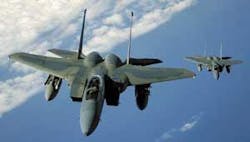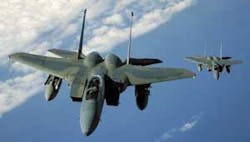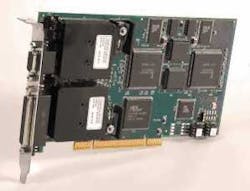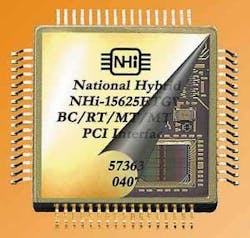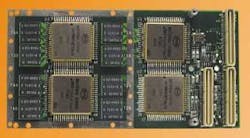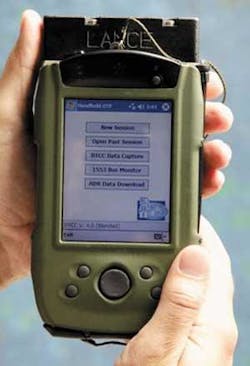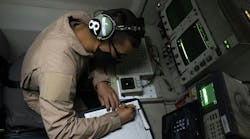Planned upgrades are set to render the venerable 1-megabit-per-second network hundreds of times faster than it is today, which will drastically increase the capabilities of existing combat systems such as the F-16 and F-15 jet fighters, C-130 airlifter, AH-64 attack helicopter, and even armored vehicles like the M1 Abrams tank and Bradley Fighting Vehicle.
By John Keller
The MIL-STD-1553 databus has been a reliable constant in a quickly changing landscape of military technology. Its proponents praise the ageing databus as one of the most reliable networks ever created. At the same time, however, the 1553’s limited throughput-just 1 megabit per second-is widely seen as an information-flow bottleneck in an increasingly data-hungry world.
While traditional 1553 will remain a fixture in military applications for the foreseeable future, developments are in the works to catapult the databus into the realm of high-speed networks to give thousands of military platforms and munitions added capabilities and new leases on life.
The MIL-STD-1553 databus represents the genesis of what we call network-centric warfare today-the most fundamental change over the past half-century in how the U.S. military and its allies take the fight to their enemies.
Since its inception in the early 1970s, the 1553 has helped transform military avionics, vetronics, and shipboard electronics from hard-wired point-to-point “federated” architectures to networked designs in which sensors, weapons, and vehicular-control subsystems share and distribute crucial information.
This evolution from federated to networked electronic architectures continues today with efforts to create a digital networked battlefield, in which a retooled 1553 databus will continue to play an important role. Network-centric warfare, put simply, connects everyone and everything involved with the military on wired or wireless data networks in much the same way that much of the world’s population is connected today via the Internet.
A high-speed 1553 databus has the potential help give existing aircraft, combat vehicles, and other military platforms much-needed capabilities such as sensor fusion, streaming video, and smart weapons, all with little or no changes to the original electronic architectures.
“It removes a barrier to improvements,” explains Darrel Hopper, principal engineer at the U.S. Air Force Research Laboratory Human Effectiveness Directorate at Wright-Patterson Air Force Base, Ohio. “If you want to put a better sensor on an airplane, it will push more bits through. If the bandwidth isn’t there, they can’t accept the technology from the lab.”
Continuing need for 1553
With built-in redundancy, the traditional 1553 functions has long been the first choice of avionics designers for in intense electromagnetic noise, withstands damage, and the effects of hasty field repairs.
“The reason for 1553 in command and control was its robustness, deterministic nature, and its ability to pull signal out of a tremendous noise environment,” explains Roy Nardin, co-president of National Hybrid Inc. of Ronkonkoma, N.Y.
The 1553 also has one of the largest installed bases of any military network. Estimates place the number of aircraft worldwide with 1553 close to 30,000, and the total number of deployed 1553 terminals, including munitions, at close to 1 million.
Such a large installed base is ripe for systems upgrades. Systems designers know by experience that the 1553 databus will work in life- and mission-critical conditions, so they are understandably reluctant to abandon something with such a performance track record. The 1553 databus, in fact, has remained unchanged for the past two decades since its Notice 2 revisions came out in 1986.
That period of stability, however, is about to come to an end, as the U.S. military and its industry suppliers seek to boost the speed of 1553. Providers range from conservative to risky in their approaches to increasing the speed of the databus, with a variety of approaches.
The “holy grail” seems it be to provide substantial increases to 1553 throughput, but with a minimum amount of structural modification. The U.S. Air Force, in fact, is sponsoring efforts to increase the speed of 1553, but using existing 1553 twisted-pair wiring and connectors. The three-part program is under supervision of the Air Force Research Laboratory and Aeronautical Systems Center at Wright-Patterson Air Force Base, Ohio, as well as the Ogden Air Logistics Center at Hill Air Force Base, Utah.
The program at the Air Force Research Lab is called MIL-STD-1553 Performance Capability Expansion to 500 Megabits Per Second. Its developments feed into the Air Force Aging Aircraft System Program Office at Wright-Patterson, and to the Ogden Air Logistics Center.
Modifying existing aircraft to carry modern high-speed networks such as Fibre Channel, Fire Wire, or Gigabit Ethernet would require removal of 1553 twisted-pair wiring and connectors, as well as modifying subsystems and payloads that today use 1553. The time and cost of such modifications for the most part simply is not practical.
“The Air Force estimates that it takes $1 million and six months to one year to rewire an existing aircraft,” explains Todd Decker, marketing manager at 1553 provider Data Device Corp. (DDC) in Bohemia, N.Y. Such an operation often requires technicians to remove and replace the skin of the aircraft to get to the 1553 wiring. “You have to use that existing wiring in a whole new way, or you have to rewire the aircraft,” Decker says.
Even if the Air Force had the money to rewire existing aircraft-which it does not-it would take 15 to 20 years to do the job, which would put most platforms at the end of their useful lives, explains the Air Force’s Hopper.
At the same time, the need to increase data throughput is paramount. “In the early 1980s weapons weren’t as sophisticated as they are today,” says National Hybrid’s Nardin. “They had room left on the bus, which was only operating 10 to 15 percent of the time. So they put other things on it, like data and video. Then the weapons became more sophisticated, and before you knew it, people said this bus is overloaded and too slow.”
Drastic increases in databus speed are not essential now, but will be in the future, Hopper explains. “Ogden [Air Logistics Center] would be hog-happy if they had 30 megabits per second, because look at the headroom that would give them compared to the 1 megabit per second they have now. For the F-16 Block 50, 30 megabits per second will take them to end-of-life on that airplane for processor, display, and sensor technology upgrades.”
Near-term projects most likely will take an incremental approach to increasing the speed of 1553-based systems, Hopper says. “They can implement more bandwidth as they want to,” he says. “You just change the terminals where you want the increased bandwidth. You have maybe 12 terminals on the bus, and perhaps only two need increased bandwidth.”
In the move to increase the 1553’s speed with little internal impact, providers often are far apart in their approaches.
The conservative camp
For some 1553 providers, the databus’s unchanged status is just fine. For them the size of the 1553’s installed base indicates a lucrative and long-lasting market that does not require them immediately to look at 1553 versions that run faster than 1 megabit per second.
“We are not really investing in some of the higher-speed 1553 activities going on,” says Steven Friedman, standard products marketing manager at Aeroflex Microelectronics in Colorado Springs, Colo. “We are spending more of our time going after the obsolescence issues of 1553. There are so many 1553 applications in aircraft and military systems in the Air Force, Navy, the Marines, and in high-end commercial industrial applications that are well entrenched, that it is painful to change designs in midstream with the need to requalify them.”
Many 1553 platforms will remain in service for decades to come and will continue to use 1553 for mission-critical command-and-control tasks like sending instructions to control surfaces and even to send instructions that fire weapons. The 1553, for example, is on late-model B-52 bombers-an aircraft that by the time the last one is retired will have been in the U.S. inventory for as long as 100 years.
Aeroflex also is tapping into legacy aircraft upgrade markets for data networking that even predate 1553. The company’s ACT 4462D universal transceiver not only supports legacy 1-megabit versions of the 1553 bus, but it also supports the so-called HOO-9 databus, designed in the early 1970s as a precursor of the 1553 to connect subsystems on the McDonnell Douglas F-15 Eagle jet fighter.
In the meantime, Aeroflex continues to offer its radiation-hardened 1553 transceiver products for space applications such as orbiting satellites. The company now offers a 5-volt 1553 transceiver, but in March will offer a new 3-volt rad-hard 1553 transceiver for new space applications.
Aeroflex engineers are paying attention to developments in high-speed 1553, yet for now are taking a wait-and-see approach to emerging new applications. “We will be taking a look at the higher-speed 1553, but we have made no business decision to go after that market right now,” Friedman says.
Toe in the water
Other 1553 providers are retaining their anchors in traditional 1-megabit applications, while making cautious forays into higher-speed realms.
Engineers at Excalibur Systems in Elmont, N.Y., for example, strongly support traditional 1-megabit 1553 with products such as a 1553-compatible rugged PocketPC that helps technicians monitor 1553 signals during flight-line maintenance, as well as the company’s Dragon PC/104-plus processor for airborne data logging and control.
Yet the company also has produced a printed circuit card that supports the so-called Miniature Munitions Stores Interface (MSSI), which moves data at 10 megabits per second with 1553-encoded signals, but over RS 485 transceivers.
“The main application is the Small Diameter Bomb,” explains George Sponsler, Excalibur’s vice president. Such multiple-munitions applications take advantage of the extra bandwidth, where traditional 1553 might experience latency problems.
“The 1553 in a stores applications is fine, as long as you only have one communications tier,” Sponsler says. “But with multiple weapons it can cause a big latency problem. It is working quite well, and we have sold it to Boeing and Lockheed.”
While 10-megabit 1553 MSSI interface solves specific application challenges, it cannot use existing 1553 wiring or connectors. “It is a custom connector specified in the Miniature Munitions Stores document,” Sponsler says. The RS 485 is a point-to-point interconnect, rather than a linear bus like 1553.
High-speed 1553 over existing wire and connectors may well see widespread application in the future, yet Excalibur officials want to see more proof before they commit to this technology. “Industry is in look-see mode, and we are waiting for things to sort themselves out,” Sponsler says.
“The government came out and said any high-performance 1553 has to operate on existing cables and connectors, and that is the big problem-getting higher-speed performance over something developed to be 1 megabit,” Sponsler says. “We looked at it for a short period of time, but we didn’t go further. We chose a different path.”
National Hybrid, likewise, is supporting traditional 1553, but is investigating higher-speed options. The company in 2002 and 2003 started offering the 15700 series of 1553 components that run at 1 and 2 megabits per second for designers who “want to add things that go a little faster, or add terminals,” Nardin says. “It buys faster speed, and doubles the number of terminals you can put on the bus.”
The 2-megabit 1553 products from National Hybrid can use existing wiring and connectors, so is a solid candidate for system upgrades.
National Hybrid also has developed a 10-megabit-per-second 1553 product, which offers benefits to military designers such as redundancy, and a true linear or “drop bus” topology, but cannot be used with existing wiring and 1553 connectors.
The company’s 10-megabit product, however, uses inexpensive standard connectors, which could benefit projects on tight budgets. “In the 10-megabit 1553 product we got rid of the coupler,” Nardin says. “Now you just snake the bus to the coupler and use a simple T connector, which is cheap. We got rid of the expensive coupler, and use terminals that cost less, which makes this attractive.”
Also firmly in the traditional 1553 camp is Condor Engineering in Santa Barbara, Calif. “The vast majority of our business-better than 90 percent-is standard, 1-megabit 1553,” says William Schuh, director of military avionics at Condor. “Most of our applications involve retrofits. There are so many boxes today that have 1553 on them that it doesn’t make sense to walk away from that.”
The 1553 bus “is very reliable and robust, and once you start standardizing weapons, you can’t go changing willy-nilly,” Schuh says. Still, he acknowledges the throughput problems that traditional 1553 presents. “With moving lots of data, 1553 doesn’t do it,” Schuh admits.
Condor, which is among the nation’s leading 1553 providers, is leveraging its 1553 expertise with a line of 1553-like products based on the SAE AS 5652 standard.
AS 5652 uses 1553 protocols, but implements on a star topology rather than a linear drop bus. Although most of its applications to date have been for weapons stores on aircraft, Schuh says AS 5652 would be a great tool for flight-control actuators, as well as high-speed throughput.
“You want to be able to mix a lot of different things on a bus,” Schuh says. “Some will run at 40 Hz, some are 100 Hz, and some are 1,000 Hz refresh rates. The 1553 can’t do that, and you need extra bandwidth to be able to do that.”
The drawback to this implementation, however, is a familiar story: it does not work well with existing 1553 wires and connectors. “We ran that 5652 over 100 feet on existing 1553 cable,” Schuh explains. “It produced a decent signal, but 5652 is natively 120 ohms, where 1553 is 75 to 78 ohms, and there is an impedance mismatch. Strictly speaking, you shouldn’t use existing 1553 wire.”
Many of these relatively high-speed approaches to 1553 might have application to new platforms or big overhauls of existing systems, yet fall short of expectations in the areas of speed and ability to use existing 1553 wire and connectors.
Commitment to high speed
At least two companies are attacking this problem head-on-Edgewater Computer Systems Inc. in Ottawa, and DDC in Bohemia, N.Y.
Edgewater is under contract to the U.S. Air Force Aging Aircraft System Program Office at Wright-Patterson Air Force Base, Ohio, to provide substantial increases to the speed of 1553 over existing 1553 wiring and connectors. So far company officials have demonstrated the ability to move 1553-encoded information in excess of 200 megabits per second over existing media.
“At the moment there is a great deal of interest in the Air Force and Navy to upgrade aging aircraft in many different programs,” says Edgewater President Duane Anderson. “Any program now is being limited because of the capacity of existing databuses.”
Edgewater’s work represents a project called Extended 1553, which during the early part of this year is expected to result in a new military and industry standard called MIL-STD-1553B Notice 5, which will be the new industry standard for high-speed 1553.
“The publicly known Extended 1553 is 200 megabits per second at the threshold,” Anderson says. “The contact with the Air Force was to develop approaches to take it to 400 megabits per second, but the official number we are putting into the Air Force spec. is 200 megabits.”
Extended 1553 essentially is two databuses for the price of one that runs over the same physical media as traditional 1553.
“Essentially the signaling is in parallel to existing 1553 signaling,” Anderson explains. “It runs in a different frequency band than existing 1553.”
Thus, an advanced 1553 databus is capable not only of running at high speeds, but can also communicate and control legacy 1553 systems such as flight controls, communications, and weapons.
“It is similar to DSL, but is a multidrop bus, not point-to-point like DSL,” Anderson explains. “It runs two separate signals over the same wire, like tuning into different channels. There is enough capacity in the existing wiring and transformers to provide enough capability for high-throughput, using the same couplers, stubs, and twisted-pair wiring. The old 1553 remains unchanged.”
Edgewater experts have run tests on an Air Force Lockheed Martin C-130J transport aircraft, and have done measurements on F-16 jet fighters, as well as in an aircraft systems integration laboratory. This achievement, Anderson makes clear, did not come easily.
“There are lots of technical and programmatic hurdles,” he says. “It is difficult to make it compatible with regular 1553. It requires an enormous amount of mathematics and signal processing, just to get a reliable high-performance interface over existing wiring in the face of the electromagnetic compatibility issues.” Extended 1553, he says, is just as reliable and immune to electromagnetic interference as traditional 1553.
Edgewater experts are implementing the Extended 1553 interface in an application-specific integrated circuit (ASIC), and are skeptical about prospects of implementing the interface on a field-programmable gate array (FPGA).
“You can’t do this in software,” Anderson says. “We require all custom interface design logic packaged as ASICs. The overall benefit of Extended 1553 is yet to be realized, but it is “a solution where you don’t have to change any mechanical parts, which is a huge competitive advantage. Right now the major benefit is for upgrading aging aircraft.”
Engineers at DDC, meanwhile, are stacking up an impressive track record in high-speed 1553, as well. In December DDC and Boeing Phantom Works in St. Louis completed a flight demonstration of DDC’s HyPer-1553 technology on a Boeing F-15E Strike Eagle jet fighter.
Boeing Phantom Works engineers used HyPer-1553 technology to transmit image data between a rugged 6U VME chassis mounted in the forward equipment bay of the F-15E and a modified Joint Direct Attack Munition (JDAM) mounted on a wing pylon station.
DDC’s HyPer-1553 also uses existing 1553 wiring and connectors to move data at 40, 80, and 120 megabits per second. The test on the F-15 jet moved data over 1553 wiring at all three speeds, says DDC’s Decker.
“It can go faster than 120 megabits,” Decker says. We can do 160 megabits per second, but the error rate so far has been unacceptable.” DDC experts are keeping a close eye out for release of MIL-STD-1553B Notice 5 later this year. Decker says HyPer-1553 will be made compatible with the new standard as soon as possible.
Decker says high-speed 1553 could be instrumental in bringing relatively old aircraft into the digital battlefield age with little modification. “We could create a new weapon subsystem that is 1553 and HyPer-1553 enabled,” he says. “The Joint Tactical Radio System [JTRS] will connect aircraft to the Global Information Grid [GIG]. Designers could replace an aircraft’s existing radio with JTRS and connect to the GIG.”
The engineering challenges of designing high-speed 1553 have been formidable, Decker says. Asked why more 1553 providers have not yet jumped on the high-speed 1553 bandwagon, he says, “High-speed 1553 is not for the timid. The technology investment is not trivial at this level.”
DDC’s approach uses technology plucked from the telecommunications industry called quadrature amplitude modulation (QAM) and discrete multitone (DMT) to speed the flow of 1553 data. In addition, traditional 1553 ships one bit per clock cycle, but HyPer-1553 ships either 2, 4, 6, or 8 bits per cycle.
DDC is implementing the HyPer-1553 as an FPGA, using the Xilinx Virtex device. “Large, high-speed FPGAs are an enabling technology,” Decker explains.
null
